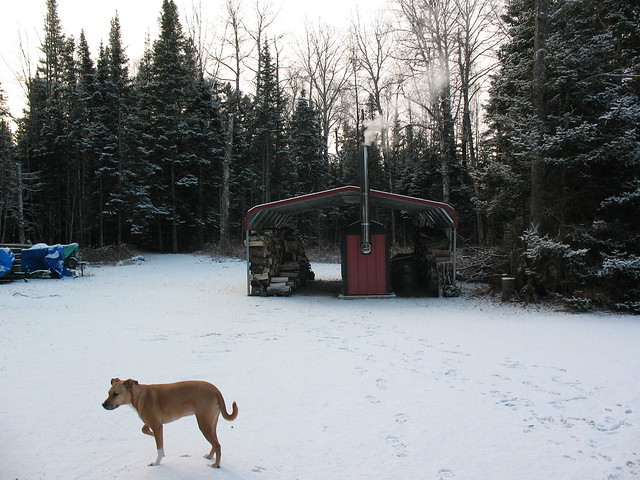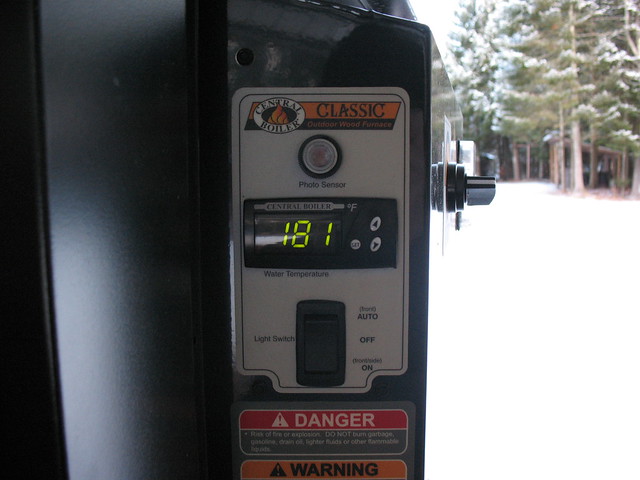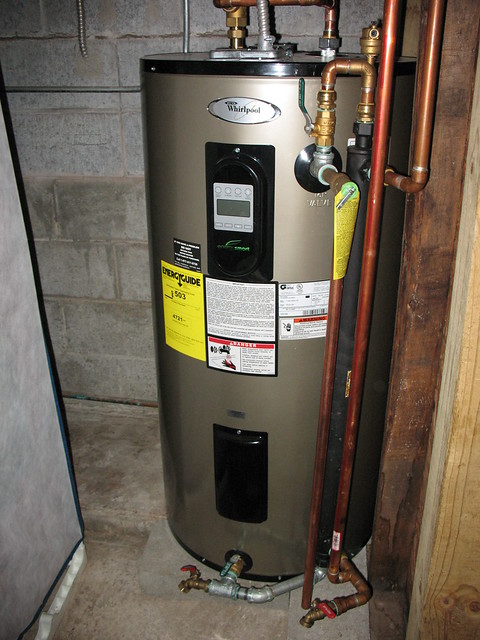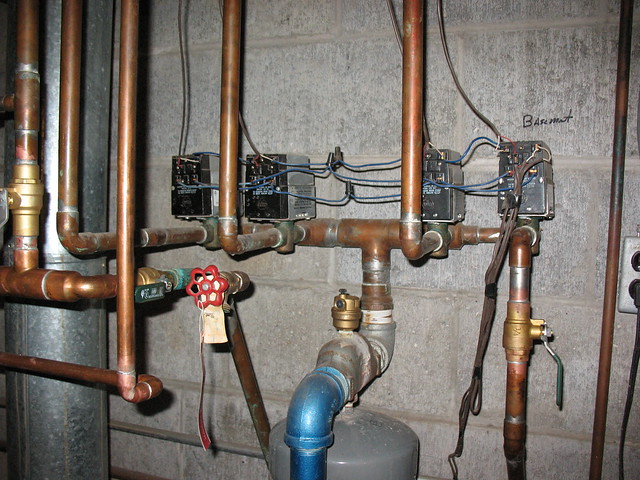We've had more than a few folks ask about our wood fired boiler system, so I figured I'd take a shot at explaining how it works. There's also the fact that I am extremely intrigued by the whole setup and won't pass up a chance to talk about it. :)
I'll start with the wood boiler itself.
In the simplest terms, an outdoor wood boiler consists of a fire box, a water jacket surrounding the fire box, and a pump to circulate the heated water into the house...where it is used for heat and then returned to the boiler water jacket. The heated water can be used in a forced air system by being pumped through a plenum or, as in our case, a baseboard heating system. The boiler's fire box is loaded with fire wood and heats the water in the water jacket to between 175 and 185 degrees.
The temperature is regulated by a thermostat which controls a damper on the door. When the temperature of the water in the water jacket drops below 175 the damper opens to allow air into the fire box. This stokes the flames to increase the temperature of the water. Once the water temperature reaches 185 the damper closes. The fire is then held to a slow burn until the water temperature drops again to 174. This minimizes the amount of wood needed. We're finding that we have to fill the fire box with wood only twice per day, in the morning and again before bed.
The pump that is mounted in the boiler runs to continuously circulate the heated water to the house, through the heat exchange system, and back to the boiler. You can also see in the picture how well insulated this boiler is. The entire unit is fully insulated, as are the lines that run underground to the house.
The heated water that is circulated by the wood boiler pump is run through two heat exchangers in the house. One is mounted to our LP fired boiler, and one is mounted to our hot water heater. The LP boiler and water heater are separate and closed systems from the wood boiler, meaning that the water from the wood boiler is not actually shared. What is shared is the heat, via the heat exhcangers. The heated water is run through the exchangers, thereby heating them to approximately 170 degrees. This heat is transferred in the heat exchanger to the water in the LP boiler and the hot water heater. Because the water is heated via the heat exchangers the LP boiler and water heater are both turned off. Yes...off...as in free heat and hot water. :)
Our system is a four zone baseboard heat system. The system is controlled by four thermostats which control the heat for the bedrooms, bathroom, basement, and living room & kitchen. The existing LP boiler supplies heated water on demand, as dictated by the thermostat for a particular zone. When the temperature in a particular zone drops below the set temperature a gate valve is opened in the boiler system. When it is fully opened the pump on the LP boiler starts, which circulates the heated water through that zone. Below are the four gate valve motors controlled by the four thermostats.
Here is a shot of the complete LP boiler system.
As far as maintenance on the wood fire boiler, it's fairly minimal. There's the twice daily stoking of the fire, of course. Then there is the need to occasionally clear the fire box of ash. Tools were provided with the boiler for doing this. The ash will be hot when removed from the boiler, so a metal container is needed. I have a 30 gallon metal drum with a hinged lid that we use. The drum should be large enough to hold the ash from an entire heating system, and we'll be spreading the ash on our garden. There is also a test that needs to be performed, basically the same as that of testing the water in a pool. This ensures that the water is properly balanced to prevent any rusting of the water jacket. There is some additional care and maintenance to be done at the end of a heating season...cleaning and lubrication...but nothing too involved.
That's about all I can think of. If you have any other questions post them and I'll respond as best I can. :)










How much wood do you put in each time you add it? AND how many cords of wood do you go through in a month. With that cost and the cost of the electricity used is it comparable or cheaper price wise to gas or propane delivery and propane set up. I know propane has to be easier (it's similar to regular gas heat which requires a thermostat set and that's it..lol) Just curious if there is an increase in efficiency or decrease in cost to make this the choice. I cant see cutting the wood yourself as fun (definitely good exercise tho)
ReplyDeleteWe're adding 2-4 pieces of wood each time. I don't know how many cords we'll use...first season. The only electrical demand would be the pump on the outside boiler, which is a low power unit, and the pump on the LP boiler, which is used on demand only. The one on the LP boiler would be used anyway if we went with LP, so the only electrical savings, if we went straight LP, would be the pump on the wood boiler. The cost of LP far outweighs the cost of wood, especially considering our supply of wood is all from our property from dead standing trees we took down or from deadfall. If we heated with LP it would be typical for us to have to fill the LP tank, a 1,000 gallon tank, twice in a heating season as a minimum. We could spend anywhere from $3K to $5K in a heating season on propane. The cost of LP fluctuates along with the price of oil/gas, which can get ugly. So, there is a massive decrease in cost with wood vs. LP. This unit will pay for itself, when compared to LP, in about 3 years.
ReplyDeleteI enjoy physical labor, or at the very least I don't shy away from it, so a little wood cutting doesn't bother me. That, and I get to play with cool toys like chainsaws and wood splitters. :)
I forgot, if I go with LP I'll be turning the breaker back on for the water heater. Whatever electrical savings I would have by turning off the water pump on the wood boiler I would lose 10x over that to run the water heater.
ReplyDeleteHow warm do you keep the house, Dave? I know my hubby would love a system like this!
ReplyDeleteOk...first the wood splitter and now this.....I'm jealous again!
ReplyDeleteDwija. We keep it at 70 during the day and 60 at night.
ReplyDeleteSara. But, this is why we bought the wood splitter. :)
ReplyDeleteI am in need a minimal help. I have a question regarding my own system. I am using only one Heat exchangers, as the hot water heater is actuall heated by the water from the boiler as well. I have looped the wood boiler through the exchanger, and have the inlet to the propane boiler looped thorugh it as well. Turning off the propane boiler means turning off the pumps? I was under the impression that the propane boiler controls the system. 160 for the in floor, 120 for the base boards, and 12o for our hot water. This type of control is not needed? I guess My question is, should I let the boiler pull water through the exchanger, and leave the boiler on? Or will it still use gas to do the water even if the water being pulled is well over 170? Or will the boiler sense that the water being pulled through it is hot enough and never actually use any gas at all?
ReplyDelete